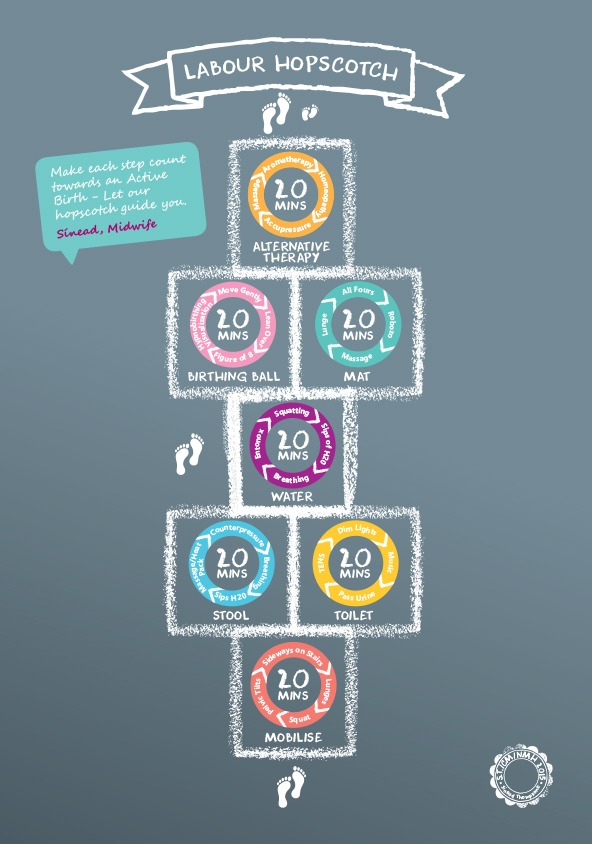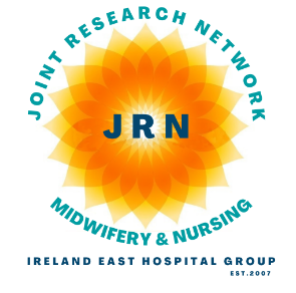
A study to Evaluate the Outcomes from the implementation of the Labour Hopscotch Framework at the National Maternity Hospital
On This Page
Introduction
This project arose from concerns about high rates of interventions, particularly epidurals and caesarean sections women experience during childbirth in Ireland. Mary Brosnan, Director of Midwifery Nursing in the National Maternity Hospital requested midwifery practitioners consider developing innovations that could facilitate normal physiological birth for women. Sinead Thompson, a community midwife who had similar concerns, began to reflect and actively doodle continued to work on her concept of a framework to promote physiological birth in an accessible, empowering format for women and their birth partners and subsequently designed and produced (Patented) a visual framework ‘Labour Hopscotch’(LHF).
(Funded by Nursing and Midwifery planning Development Unit €17,500)
Project Outline
This framework was developed from Sinead’s understanding of the physiology of labour and midwifery knowledge and expertise gained from 20 years of supporting women during childbirth. The framework is set out in a systematic manner in conjunction with normal physiological labour and aligns with the normal responses to progression during an active labour and birth months produced the Labour Hopscotch Framework which was implemented formally in 2017.
A sub-group of a Joint Research Network (JRN) between University College Dublin SNMHS and the National Maternity Hospital completed a mixed methods output evaluation of the Labour Hopscotch Framework. Study design comprising of a descriptive survey with service users and focus group meetings with midwives conducted over an 18 month period
Research Project Video
The Labour Hopscotch Framework: improving outcomes for mother and baby
(opens in a new window)https://www.youtube.com/watch?v=xLf_bD3z8bg
Detailed Project Description
As part of the implementation process Sinead, Denise and a team from the Joint Research Network at UCD SNMHS and the National Maternity Hospital completed an output evaluation of the Labour Hopscotch Framework. A two phased mixed-method sequential explanatory design study consisting of a survey [women, n= 809 and partners, n=759] and focus group [n=8 Midwives] was undertaken. The findings and final report: An evaluation of the labour hopscotch framework at the National Maternity Hospital were published (Thompson et al.,2019) and highlighted that adopting the LHF can lead to a reduction in LSCS rates, and epidural rates among participants. See link:
From a total of 809 women, 38.5% reported having epidural analgesia while using the LHF, lower than the hospital epidural rate of 52%. Furthermore 77% had a physiological birth, 9% had a caesarean birth, lower than the hospital rate of 29%. Perhaps of equal if not more importance, birth satisfaction, and positives such as shared decision-making, choice of options and partner engagement were enhanced. Additionally, all key stakeholders have reported that implementing the LHF has resulted in positive changes: women take on more initiatives during childbirth, using steps of the LHF with coaching from their birth partner or midwives, enhancing confidence and nurturing their personal relationships. Women reported feelings of empowerment as did midwives and rates of physiological birth were higher.
Project Outputs
Framework Graphic

The team were invited to present the findings of the project to the executive steering committee of NWIHP in the Department of Health. The outcome was a national rollout of the LHF to each of the 19 maternity Hospitals through the support of National Women’s Infant Programme (NWIHP). In addition, the Labour hopscotch was included into the National Standards for Antenatal education and the national resource guide for educators.
Publications:
O’Brien, D., Coughlan, B., Thompson, S., Carroll, L., Sheehy, L., Brosnan, M., Cronin, M., McCreery, T. and Doherty, J., 2022. Exploring midwives’ experiences of implementing the Labour Hopscotch Framework: A midwifery innovation. European Journal of Midwifery, 6, p.18.
Carroll, L., Thompson, S., Coughlan, B., McCreery, T., Murphy, A., Doherty, J., Sheehy, L., Cronin, M., Brosnan, M. and O’Brien, D., 2022. ‘Labour Hopscotch’: Women’s evaluation of using the steps during labor. European Journal of Midwifery, 6, p.59.
O’Brien, D., Coughlan, B., Thompson, S., Carroll, L., Sheehy, L., Brosnan, M., Cronin, M., McCreery, T. and Doherty, J., 2022. Exploring midwives’ experiences of implementing the Labour Hopscotch Framework: A midwifery innovation. European Journal of Midwifery, 6, p.18.
IMPACT CASE STUDY 2022 Winner: The Labour Hopscotch Framework: improving outcomes for mother and baby: See link to read more about the project here.
Project Team
-1.png)
Dr. Lorraine Carroll
Director of Undergraduate Clinical Studies Assistant Professor
My Research Profile
Sinead Thompson
BSc CLINICAL Tutor Midwifery
Trinity College Dublin

Lucille Sheehy
CMMIII Practice Development Coordinator MSc BSc
National Maternity Hospital

Teresa McCreery
CMMIII National Maternity Hospital
National Maternity Hospital

Mrs Cronin
CMMIII BSc National Maternity Hospital
National Maternity Hospital

Jean Doherty
MSc BSc National Maternity Hospital
National Maternity Hospital

.png)

.png)

